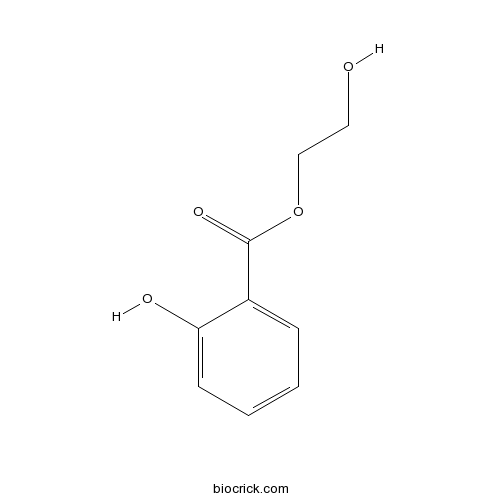2-Hydroxyethyl SalicylateCAS# 87-28-5 |

Quality Control & MSDS
3D structure
Package In Stock
Number of papers citing our products

| Cas No. | 87-28-5 | SDF | Download SDF |
| PubChem ID | 6880 | Appearance | Colorless liquid (> 20°c) |
| Formula | C9H10O4 | M.Wt | 182.18 |
| Type of Compound | Phenols | Storage | Desiccate at -20°C |
| Synonyms | 2-Hydroxyethyl 2-hydroxybenzoate | ||
| Solubility | DMSO : 160 mg/mL (878.30 mM; Need ultrasonic and warming) | ||
| Chemical Name | 2-hydroxyethyl 2-hydroxybenzoate | ||
| SMILES | C1=CC=C(C(=C1)C(=O)OCCO)O | ||
| Standard InChIKey | LVYLCBNXHHHPSB-UHFFFAOYSA-N | ||
| Standard InChI | InChI=1S/C9H10O4/c10-5-6-13-9(12)7-3-1-2-4-8(7)11/h1-4,10-11H,5-6H2 | ||
| General tips | For obtaining a higher solubility , please warm the tube at 37 ℃ and shake it in the ultrasonic bath for a while.Stock solution can be stored below -20℃ for several months. We recommend that you prepare and use the solution on the same day. However, if the test schedule requires, the stock solutions can be prepared in advance, and the stock solution must be sealed and stored below -20℃. In general, the stock solution can be kept for several months. Before use, we recommend that you leave the vial at room temperature for at least an hour before opening it. |
||
| About Packaging | 1. The packaging of the product may be reversed during transportation, cause the high purity compounds to adhere to the neck or cap of the vial.Take the vail out of its packaging and shake gently until the compounds fall to the bottom of the vial. 2. For liquid products, please centrifuge at 500xg to gather the liquid to the bottom of the vial. 3. Try to avoid loss or contamination during the experiment. |
||
| Shipping Condition | Packaging according to customer requirements(5mg, 10mg, 20mg and more). Ship via FedEx, DHL, UPS, EMS or other couriers with RT, or blue ice upon request. | ||
| Description | 1. Carbamazepine, (5H-dibenz[b,f]azepine)-5-carboxamide, a potent anticonvulsant drug. |

2-Hydroxyethyl Salicylate Dilution Calculator

2-Hydroxyethyl Salicylate Molarity Calculator
| 1 mg | 5 mg | 10 mg | 20 mg | 25 mg | |
| 1 mM | 5.4891 mL | 27.4454 mL | 54.8908 mL | 109.7815 mL | 137.2269 mL |
| 5 mM | 1.0978 mL | 5.4891 mL | 10.9782 mL | 21.9563 mL | 27.4454 mL |
| 10 mM | 0.5489 mL | 2.7445 mL | 5.4891 mL | 10.9782 mL | 13.7227 mL |
| 50 mM | 0.1098 mL | 0.5489 mL | 1.0978 mL | 2.1956 mL | 2.7445 mL |
| 100 mM | 0.0549 mL | 0.2745 mL | 0.5489 mL | 1.0978 mL | 1.3723 mL |
| * Note: If you are in the process of experiment, it's necessary to make the dilution ratios of the samples. The dilution data above is only for reference. Normally, it's can get a better solubility within lower of Concentrations. | |||||

Calcutta University

University of Minnesota

University of Maryland School of Medicine

University of Illinois at Chicago

The Ohio State University

University of Zurich

Harvard University

Colorado State University

Auburn University

Yale University

Worcester Polytechnic Institute

Washington State University

Stanford University

University of Leipzig

Universidade da Beira Interior

The Institute of Cancer Research

Heidelberg University

University of Amsterdam

University of Auckland

TsingHua University

The University of Michigan

Miami University

DRURY University

Jilin University

Fudan University

Wuhan University

Sun Yat-sen University

Universite de Paris

Deemed University

Auckland University

The University of Tokyo

Korea University
- (3R)-(+)-1-Benzyl-3-(tert-butoxycarbonylamino)pyrrolidine
Catalog No.:BCC8389
CAS No.:131878-23-4
- Lexacalcitol
Catalog No.:BCC1704
CAS No.:131875-08-6
- (R,R)-2,6-Bis(4-isopropyl-2-oxazolin-2-yl)pyridine
Catalog No.:BCC8396
CAS No.:131864-67-0
- Aphagranin A
Catalog No.:BCN6889
CAS No.:1318173-53-3
- Cardenolide B-1
Catalog No.:BCN4714
CAS No.:1318158-89-2
- Ugaxanthone
Catalog No.:BCN6775
CAS No.:13179-11-8
- DAU 5884 hydrochloride
Catalog No.:BCC7263
CAS No.:131780-48-8
- Flavopiridol hydrochloride
Catalog No.:BCC3925
CAS No.:131740-09-5
- Urolignoside
Catalog No.:BCN6758
CAS No.:131723-83-6
- Arbidol HCl
Catalog No.:BCC3722
CAS No.:131707-23-8
- (R)-(-)-4-Benzyl-3-propionyl-2-oxazolidinone
Catalog No.:BCC8392
CAS No.:131685-53-5
- Parsonsianine
Catalog No.:BCN2110
CAS No.:131683-36-8
- Fudosteine
Catalog No.:BCC4661
CAS No.:13189-98-5
- Goitrin
Catalog No.:BCN2764
CAS No.:13190-34-6
- Solanesol
Catalog No.:BCN2596
CAS No.:13190-97-1
- Paricalcitol
Catalog No.:BCC1839
CAS No.:131918-61-1
- 1,3,6,8-tetrahydroxy-4-(3-methyl-2-buten-1-yl)-9H-Xanthen-9-one
Catalog No.:BCN1585
CAS No.:1319198-98-5
- CC0651
Catalog No.:BCC4200
CAS No.:1319207-44-7
- 3,6,19-Trihydroxy-23-oxo-12-ursen-28-oic acid
Catalog No.:BCN1584
CAS No.:131984-82-2
- Shizukaol A
Catalog No.:BCN6984
CAS No.:131984-98-0
- Benztropine mesylate
Catalog No.:BCC4524
CAS No.:132-17-2
- Diphenylpyraline HCl
Catalog No.:BCC3768
CAS No.:132-18-3
- Pheniramine Maleate
Catalog No.:BCC4700
CAS No.:132-20-7
- Benzydamine HCl
Catalog No.:BCC4637
CAS No.:132-69-4
[Clinical trial of the new percutaneously active antirheumatic etofenamate. Summarising report (author's transl)].[Pubmed:144509]
Arzneimittelforschung. 1977;27(6B):1357-63.
2-(2-Hydroxyethoxy)ethyl-N-(a,a,a-trifluoro-m-tolyl)anthranilate (etofenamate, Rheumon Gel), a percutaneously active antirheumatic containing etofenamate as active principle has been subjected to clinical studies in both hospitalized and out-patients in various types of rheumatic disease. These trials included double-blind studies against placebo gel, controlled comparative studies against two topical commercial products (ointmentI: combination of 2-Hydroxyethyl Salicylate and p-menthan-3-ol; ointment II: 3,5-dioxo-1,2-diphenyl-4-n-butylpyrazolidine) and open trials for efficacy and tolerance. Of the 760 patients taking part in the trials, 556 were treated with Rheumon Gel.


